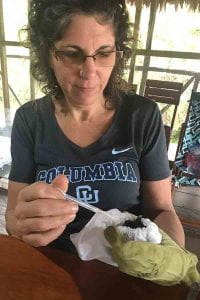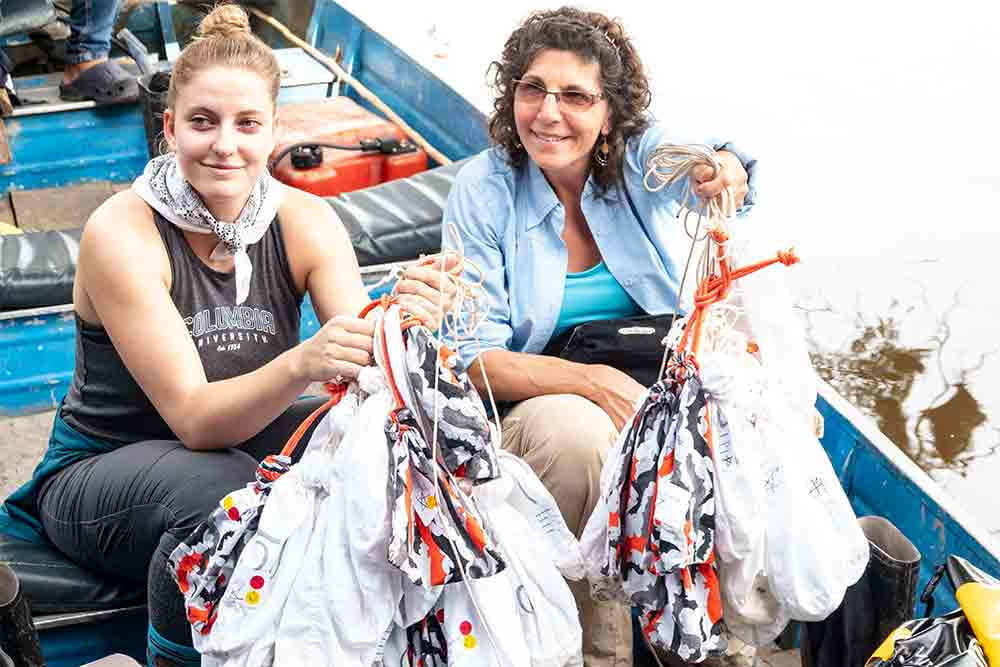Photo above: Maria Brown and daughter Lexi prepare at dawn to return to the location in Peru’s Tamshiyacu-Tahuayo Reserve where bats were captured the night before. The bats were released back into the wild. Photo credit Melissa Ingala
From Maria Brown Goes to Bat for Bats on Stony Brook University News on April 9, 2021 by Robert Emproto
They’ve been called creepy, scary and spooky, but Maria Brown says don’t be fooled, and don’t be afraid. Bats are an important species that impacts our daily lives in ways we might not even realize, including pollinating our favorite fruits and eating pesky and harmful insects.
In fact, bats are tremendously important for Brown, a lecturer at the School of Marine and Atmospheric Sciences at Stony Brook University.
“I was that weird kid and showed up at the front door with a snake in one hand and a frog in the other and my mother would be freaking out,” she said. “I remember just lying in the grass with a flashlight and watching the bats in my yard swooping over the pool feeding on insects at dusk. Even back then I thought they were really cool.”
After spending the first decade of her career as an environmental and wetland scientist, Brown became a high school science teacher, a move that would put her back on a path to rekindle her childhood interest in bats, botany and other wildlife.
“I started traveling with my AP environmental science students to Costa Rica in 2005 and on one trip to the Osa Peninsula they took us to a place called the ‘Bat Cave’ in the Campanario Biological Field Station,” she said. “I had about 20 students with me and we sat just outside the cave on the rocks right on the Pacific Ocean, and about 40,000 mustached bats emerged at dusk. It was like sitting in the middle of a National Geographic video. I thought it was the most incredible thing ever.”
Brown’s daughter Alexis accompanied her on the first trip when she was just 11. After years of studying mustached bats, she was considered the youngest expert at the Field Station on them by the time she was 18. She is currently a Ph.D. student in the Department of Ecology and Evolution at Stony Brook, conducting research in the Dávalos Lab, led by Liliana Dávalos, professor of Conservation Biology.
Years later, a conversation at an industry event would further inspire Brown. Every year, the Seatuck Environmental Association, a non-profit dedicated to preserving Long Island’s wildlife and environment, organizes a local event called Bats and Brews.

Maria Brown hydrates a bat before releasing it back into the wild in the Peruvian Amazon. Photo credit Melissa Ingala
“It’s the biggest bat-related event that’s held on Long Island,” said Brown, who has been a keynote speaker in the past. In 2018, Seatuck director Enrico Nardone approached Brown with a curious observation.
“He said ‘Maria, we’ve been doing Bats and Brews for a long time and I realized that we have no bat research going on here,’” she says. “He was right. We don’t know much about the historical distribution of bats on Long Island. We don’t have good evidence for any of the eight species encountered on Long Island.”
When Brown saw how little was known about the bat population in her own backyard, she began to rectify that. The first challenge was to figure out where the bats are. Brown says that the lack of caves on Long Island makes it more difficult to track them. In the absence of caves, bats squeeze under the barks of trees and get into attics, overhangs, tree hollows and sometimes basements.
“Once we figure out where they are, we can go out and do some bio-acoustical monitoring and see who’s in the neighborhood,” she says. After that, she can apply for permits to do net captures and study the bat population.
Brown, who teaches geographic information systems at Stony Brook, created a bat-tracking app, which is loaded on a cellphone. When she lectures, she hands out business cards with a bar code on the back. Fellow bat fans download the app and use the card to log both locational and behavioral information whenever they spot bats on Long Island.
“We need to know flight details as well as the time they were observed,” explained Brown, adding that behavioral patterns helps narrow down the species to identify the bats. “It’s a great citizen science project right now, but this can lead to important research opportunities for students on Long Island.”
To help further the cause, Brown has assembled a network of high school and middle school science teachers through the New York State Master Teacher program, some of whom are doing authentic research with their students.
The study’s pilot season was in 2019. However, because of the COVID pandemic, the outreach was slowed down in 2020. But Brown says she still received approximately 150 survey responses between the spring-fall seasons of 2019 and 2020.
“We’ve begun to analyze the data from the app and the pilot study shows that we have people participating,” she said.
Of particular concern is a fungal disease called white nose syndrome that has devastated the bat community. It has killed scores of hibernating bats and has progressively moved westward since first being discovered in upstate New York in 2006, and on Long Island in 2011. Brown says that more than seven million bats have been lost in the northeastern U.S.
Moving forward, she says it’s important to help people understand the benefits of having an insectivorous bat population, especially on Long Island.
“Some bats can eat over a thousand mosquitoes in an hour,” she said. “They help with pest control, which in the U.S. alone is close to $8 billion a year that insectivores save farmers.”
She also hopes to dispel other misconceptions due to the COVID pandemic and the negative press bats received about being the source of the virus. Brown mentioned horrific stories about remote villages setting caves aflame because of a misunderstanding of what was going on around the world.
“It’s important that people understand more about zoonotic diseases [infectious diseases caused by a pathogen] and how they’re transmitted,” she said. “There are a lot of misconceptions connected to bats. Everybody thinks of Dracula and these evil creatures of the night, but they’re not that like at all. Bats have no interest in people. But the more we encroach on their habitats, the more frequent encounters between humans and bats will be. If you’ve got bats in your yard, you should be celebrating.”
This summer Brown has set her sights on applying for grants to secure more equipment, which would enable large-scale training for interested Long Island teachers and help support authentic research for young emerging scientists.
“Right now it’s just working with a couple of teachers and organizations here and there during this pilot study period,” said Brown. “But many others have expressed interest, and if there’s funding to support the training, they would do it. If we can go from a handful of teachers to maybe 40 spread across Long Island, that would be amazing for the first year of training.”




